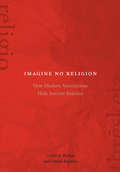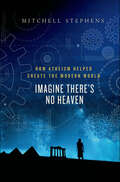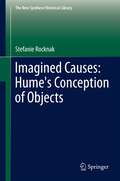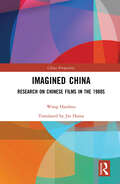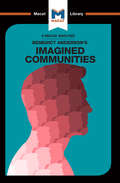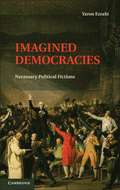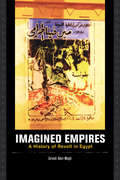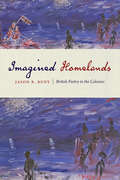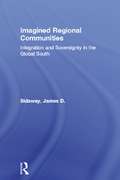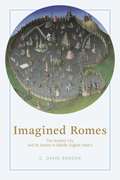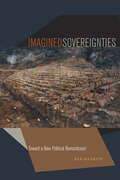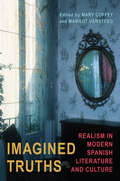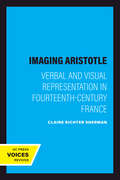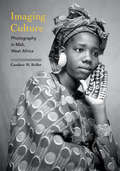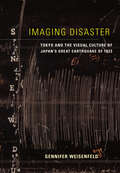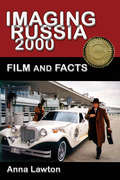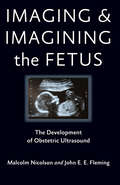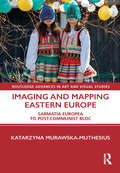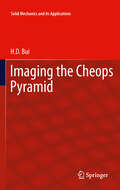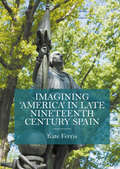- Table View
- List View
Imagine No Religion: How Modern Abstractions Hide Ancient Realities
by Daniel Boyarin Carlin A. BartonWhat do we fail to see when we force other, earlier cultures into the Procrustean bed of concepts that organize our contemporary world? In Imagine No Religion, Carlin A. Barton and Daniel Boyarin map the myriad meanings of the Latin and Greek words religio and thrēskeia, frequently and reductively mistranslated as “religion,” in order to explore the manifold nuances of their uses within ancient Roman and Greek societies. In doing so, they reveal how we can conceptualize anew and speak of these cultures without invoking the anachronistic concept of religion. From Plautus to Tertullian, Herodotus to Josephus, Imagine No Religion illuminates cultural complexities otherwise obscured by our modern-day categories.
Imagine That!
by Janet WilsonOn her hundredth birthday, Auntie Violet reminisces with her great grandniece, and wonders at all the changes that have taken place in her lifetime. Violet tries to imagine what she could wish for that hasn't already come true. By the time the cake and candles arrive, she has the perfect answer. This look at one of the most amazing centuries of all time offers a wealth of information. Topics range from inventions, fashion, history, and medicine to entertainment, toys, food, and transportation. Sidebars for each decade are color coded to match pictures within the illustrations, creating a search-and-find activity for all ages. Image Descriptions Present.
Imagine There's No Heaven: How Atheism Helped Create the Modern World
by Mitchell StephensThe historical achievements of religious belief have been large and well chronicled. But what about the accomplishments of those who have challenged religion? Traveling from classical Greece to twenty-first century America, Imagine There's No Heaven explores the role of disbelief in shaping Western civilization. At each juncture common themes emerge: by questioning the role of gods in the heavens or the role of a God in creating man on earth, nonbelievers help move science forward. By challenging the divine right of monarchs and the strictures of holy books, nonbelievers, including Jean- Jacques Rousseau and Denis Diderot, help expand human liberties, and influence the early founding of the United States. Revolutions in science, in politics, in philosophy, in art, and in psychology have been led, on multiple occasions, by those who are free of the constraints of religious life. Mitchell Stephens tells the often-courageous tales of history's most important atheists— like Denis Diderot and Salman Rushdie. Stephens makes a strong and original case for their importance not only to today's New Atheist movement but to the way many of us—believers and nonbelievers—now think and live.
Imagine a City That Remembers: The Albuquerque Rephotography Project (Querencias Series)
by Mark C. Childs Anthony AnellaImagine a City That Remembers grew out of a series of articles and photographs published in the Albuquerque Tribune in 1998 and 1999. This expanded and updated collection revisits Albuquerque nearly twenty years after the original articles were written. It juxtaposes historic and contemporary photographs of Albuquerque to show diverse moments in the city&’s history and development. The authors, ardent defenders of the vitality of Albuquerque&’s past, contend that the city is still small enough to be in touch with its history and argue that what makes Albuquerque a great place is the continued presence of its strong traditions. They further believe that preserving Albuquerque&’s natural and cultural heritage is critical to the city&’s future. Throughout, both express a deep understanding for this complicated, beautiful, and often misunderstood place.
Imagined Causes: Hume's Conception of Objects
by Stefanie RocknakThis book provides the first comprehensive account of Hume's conception of objects in Book I of A Treatise of Human Nature. What, according to Hume, are objects? Ideas? Impressions? Mind-independent objects? All three? None of the above? Through a close textual analysis, Rocknak shows that Hume thought that objects are imagined ideas. But, she argues, he struggled with two accounts of how and when we imagine such ideas. On the one hand, Hume believed that we always and universally imagine that objects are the causes of our perceptions. On the other hand, he thought that we only imagine such causes when we reach a "philosophical" level of thought. This tension manifests itself in Hume's account of personal identity; a tension that, Rocknak argues, Hume acknowledges in the Appendix to the Treatise. As a result of Rocknak's detailed account of Hume's conception of objects, we are forced to accommodate new interpretations of, at least, Hume's notions of belief, personal identity, justification and causality.
Imagined China: Research on Chinese Films in the 1980s (China Perspectives)
by Wang HaizhouThis book explores how Chinese films constructed an image of China in the 1980s through analyzing the characters, composition of space, and conflict patterns of the films. It also examines the relationship between the representations in Chinese cinema and the realities of Chinese society. The study analyzes the imagery, metaphors, and cultural values of Chinese films in the 1980s to discover the common creative focus of Chinese film directors at the time. It also examines the specific creative elements and cultural significance of Chinese cinema in the 1980s. This book is neither a “period history” of Chinese cinema in the 80s, nor a thematic study of the “fifth generation”. Rather, it is an analysis of films as narrative texts that reflected on history. It uses the perspectives revealed by characters, narrative patterns, and conflicts in films of the 1980s to examine how the era was perceived at that time as well as how China’s national future and individuals’ personal futures were being conceptualized. This title will be a valuable resource for scholars and students of Chinese Studies, Contemporary China Studies, Film Studies, and those who are interested in Chinese culture and society in general.
Imagined Communities
by Jason XidiasBenedict Anderson’s 1983 masterpiece Imagined Communities is a ground-breaking analysis of the origins and meanings of “nations” and “nationalism”. A book that helped reshape the field of nationalism studies, Imagined Communities also shows the critical thinking skills of interpretation and analysis working at their highest levels. One crucial aspect of Anderson’s work involves the apparently simple act of defining precisely what we mean when we say ‘nation’ or ‘nationalism’ – an interpretative step that is vital to the analysis he proceeds to carry out. For Anderson, it is clear that nations are not ‘natural;’ as historians and anthropologists are well aware, nations as we understand them are a relatively modern phenomenon, dating back only as far as around 1500. But if this is the case, how can we agree what a ‘nation’ is? Anderson’s proposed definition is that they are “imagined communities” – comprising groups of people who regard themselves as belonging to the same community, even if they have never met, and have nothing in common otherwise. The analysis that follows from this insight is all about examining and breaking down the historical processes that helped foster these communities – above all the birth of printing, and the development of capitalism. Brilliantly incisive, Anderson’s analysis shows how good interpretative skills can form the foundations for compelling and original insight.
Imagined Democracies
by Yaron EzrahiThis book proposes a revisionist approach to democratic politics. Yaron Ezrahi focuses on the creative unconscious collective imagination that generates ever-changing visions of legitimate power and authority, which compete for enactment and institutionalization in the political arena. If, in the past, political authority was grounded in fictions such as the divine right of kings, the laws of nature, historical determinism and scientism, today the space of democratic politics is filled with multiple alternative social imaginaries of the desirable political order. Exposure to electronic mass media has made contemporary democratic publics more aware that credible popular fictions have greater impact on shaping our political realities than do rational social choices or moral arguments. The pressing political question in contemporary democracy is, therefore, how to select and enact political fictions that promote peace and how to found the political order on checks and balances between alternative political imaginaries of freedom and justice.
Imagined Empires
by Zeinab Abul-MagdThrough a microhistory of a small province in Upper Egypt, this book investigates the history of five world empires that assumed hegemony in Qina province over the last five centuries. Imagined Empires charts modes of subaltern rebellion against the destructive policies of colonial intruders and collaborating local elites in the south of Egypt. Abul-Magd vividly narrates stories of sabotage, banditry, flight, and massive uprisings of peasants and laborers, to challenge myths of imperial competence. The book depicts forms of subaltern discontent against "imagined empires" that failed in achieving their professed goals and brought about environmental crises to Qina province. As the book deconstructs myths about early modern and modern world hegemons, it reveals that imperial modernity and its market economy altered existing systems of landownership, irrigation, and trade-- leading to such destructive occurrences as the plague and cholera epidemics. The book also deconstructs myths in Egyptian historiography, highlighting the problems of a Cairo-centered idea of the Egyptian nation-state. The book covers the Ottoman, French, Muhammad Ali's, and the British informal and formal empires. It alludes to the U.S. and its failed market economy in Upper Egypt, which partially resulted in Qina's participation in the 2011 revolution. Imagined Empires is a timely addition to Middle Eastern and world history.
Imagined Homelands: British Poetry in the Colonies
by Jason R. RudyA ground-breaking study of nineteenth-century British colonial poetry.Imagined Homelands chronicles the emerging cultures of nineteenth-century British settler colonialism, focusing on poetry as a genre especially equipped to reflect colonial experience. Jason Rudy argues that the poetry of Victorian-era Australia, New Zealand, South Africa, and Canada—often disparaged as derivative and uncouth—should instead be seen as vitally engaged in the social and political work of settlement. The book illuminates cultural pressures that accompanied the unprecedented growth of British emigration across the nineteenth century. It also explores the role of poetry as a mediator between familiar British ideals and new colonial paradigms within emerging literary markets from Sydney and Melbourne to Cape Town and Halifax. Rudy focuses on the work of poets both canonical—including Tennyson, Browning, Longfellow, and Hemans—and relatively obscure, from Adam Lindsay Gordon, Susanna Moodie, and Thomas Pringle to Henry Kendall and Alexander McLachlan. He examines in particular the nostalgic relations between home and abroad, core and periphery, whereby British emigrants used both original compositions and canonical British works to imagine connections between their colonial experiences and the lives they left behind in Europe.Drawing on archival work from four continents, Imagined Homelands insists on a wider geographic frame for nineteenth-century British literature. From lyrics printed in newspapers aboard emigrant ships heading to Australia and South Africa, to ballads circulating in New Zealand and Canadian colonial journals, poetry was a vibrant component of emigrant life. In tracing the histories of these poems and the poets who wrote them, this book provides an alternate account of nineteenth-century British poetry and, more broadly, of settler colonial culture.
Imagined Homes: Soviet German Immigrants in Two Cities (Studies in Immigration and Culture #1)
by Hans WernerImagined Homes: Soviet German Immigrants in Two Cities is a study of the social and cultural integration of two migrations of German speakers from Eastern Europe and the Soviet Union to Winnipeg, Canada in the late 1940s, and Bielefeld, Germany in the 1970s. Employing a cross-national comparative framework, Hans Werner reveals that the imagined trajectory of immigrant lives influenced the process of integration into a new urban environment. Winnipeg’s migrants chose a receiving society where they knew they would again be a minority group in a foreign country, while Bielefeld’s newcomers believed they were “going home” and were unprepared for the conflict between their imagined homeland and the realities of post-war Germany. Werner also shows that differences in the way the two receiving societies perceived immigrants, and the degree to which secularization and the sexual and media revolutions influenced these perceptions in the two cities, were crucially important in the immigrant experience.
Imagined Regional Communities: Integration and Sovereignty in the Global South (Routledge Studies in Human Geography #Vol. 5)
by James D. SidawayImagined Regional Communities provides an original approach to thinking about the processes of regional integration. Focusing mostly on communities in Africa, Asia and Latin America, it develops detailed case studies based on archives, interviews and critical readings of existing texts. These case-studies are related to each other and the overall themes of the book, so that a set of narratives and theoretical elaborations emerge, that critically reformulate understandings of regional communities, statehold and sovereignty.
Imagined Romes: The Ancient City and Its Stories in Middle English Poetry
by C. David BensonThis volume explores the conflicting representations of ancient Rome—one of the most important European cities in the medieval imagination—in late Middle English poetry.Once the capital of a great pagan empire whose ruined monuments still inspired awe in the Middle Ages, Rome, the seat of the pope, became a site of Christian pilgrimage owing to the fame of its early martyrs, whose relics sanctified the city and whose help was sought by pilgrims to their shrines. C. David Benson analyzes the variety of ways that Rome and its citizens, both pre-Christian and Christian, are presented in a range of Middle English poems, from lesser-known, anonymous works to the poetry of Gower, Chaucer, Langland, and Lydgate. Benson discusses how these poets conceive of ancient Rome and its citizens—especially the women of Rome—as well as why this matters to their works.An insightful and innovative study, Imagined Romes addresses a crucial lacuna in the scholarship of Rome in the medieval imaginary and provides fresh perspectives on the work of four of the most prominent Middle English poets.
Imagined Romes: The Ancient City and Its Stories in Middle English Poetry
by C. David BensonThis volume explores the conflicting representations of ancient Rome—one of the most important European cities in the medieval imagination—in late Middle English poetry.Once the capital of a great pagan empire whose ruined monuments still inspired awe in the Middle Ages, Rome, the seat of the pope, became a site of Christian pilgrimage owing to the fame of its early martyrs, whose relics sanctified the city and whose help was sought by pilgrims to their shrines. C. David Benson analyzes the variety of ways that Rome and its citizens, both pre-Christian and Christian, are presented in a range of Middle English poems, from lesser-known, anonymous works to the poetry of Gower, Chaucer, Langland, and Lydgate. Benson discusses how these poets conceive of ancient Rome and its citizens—especially the women of Rome—as well as why this matters to their works.An insightful and innovative study, Imagined Romes addresses a crucial lacuna in the scholarship of Rome in the medieval imaginary and provides fresh perspectives on the work of four of the most prominent Middle English poets.
Imagined Sovereignties: Toward a New Political Romanticism
by Kir KuikenImagined Sovereignties argues that the Romantics reconceived not just the nature of aesthetic imagination but also the conditions in which a specific form of political sovereignty could be realized through it.Articulating the link between the poetic imagination and secularized sovereignty requires more than simply replacing God with the subjective imagination and thereby ratifying the bourgeois liberal subject. Through close readings of Blake, Coleridge, Wordsworth, and Shelley, the author elucidates how Romanticism’s reassertion of poetic power in place of the divine sovereign articulates an alternative understanding of secularization in forms of sovereignty that are no longer modeled on transcendence, divine or human.These readings ask us to reexamine not only the political significance of Romanticism but also its place within the development of modern politics. Certain aspects of Romanticism still provide an important resource for rethinking the limits of the political in our own time. This book will be a crucial source for those interested in the political legacy of Romanticism, as well as for anyone concerned with critical theoretical approaches to politics in the present.
Imagined Truths: Realism in Modern Spanish Literature and Culture (Toronto Iberic)
by Mary L. Coffey Margot VersteegImagined Truths provides a twenty-first-century analysis of stylistic and philosophical manifestations of nineteenth- and twentieth-century Spanish literary realism. Bringing together the work of the foremost specialists in the field of contemporary Spanish letters, this collection offers new approaches to literary and cultural criticism and reveals how Spanish realism, far from being imitative of other European movements, engaged in complex and modern concepts of representation and mimesis. Imagined Truths acknowledges the critical importance of women writers and contemporary approaches to questions of gender. The essays address the impact of economics on our perceptions of reality and our constructions of everyday life, and they argue for the importance of emotions in the social construction of individual identity. Most importantly, they also acknowledge the post-imperial turn in literary studies. Addressing a broad range of authors, works, and topics, from the continued relevance of Cervantes’ Don Quijote to Spanish realism’s ability to move beyond narrative to inhabit the spaces of both theatre and film, Imagined Truths constitutes a series of meditations on new ways for understanding the unique place of realism in Spain’s cultural history. Offering insights for specialists in a wide range of disciplines, including literature, cultural studies, gender studies, history, and philosophy, this collection is equally important for readers becoming acquainted with realist narrative as a central component of Spanish literary history.
Imaging Aristotle: Verbal and Visual Representation in Fourteenth-Century France
by Claire Richter ShermanThis title is part of UC Press's Voices Revived program, which commemorates University of California Press’s mission to seek out and cultivate the brightest minds and give them voice, reach, and impact. Drawing on a backlist dating to 1893, Voices Revived makes high-quality, peer-reviewed scholarship accessible once again using print-on-demand technology. This title was originally published in 1995.This title is part of UC Press's Voices Revived program, which commemorates University of California Press’s mission to seek out and cultivate the brightest minds and give them voice, reach, and impact. Drawing on a backlist dating to 1893, Voices Revived</DIV
Imaging Culture: Photography in Mali, West Africa (African Expressive Cultures)
by Candace M. KellerImaging Culture is a sociohistorical study of the meaning, function, and aesthetic significance of photography in Mali, West Africa, from the 1930s to the present. Spanning the dynamic periods of colonialism, national independence, socialism, and democracy, its analysis focuses on the studio and documentary work of professional urban photographers, particularly in the capital city of Bamako and in smaller cities such as Mopti and Ségu. Featuring the work of more than twenty-five photographers, it concentrates on those who have been particularly influential for the local development and practice of the medium as well as its international popularization and active participation in the contemporary art market. Imaging Culture looks at how local aesthetic ideas are visually communicated in the photographers' art and argues that though these aesthetic arrangements have specific relevance for local consumers, they transcend geographical and cultural boundaries to have value for contemporary global audiences as well. Imaging Culture is an important and visually interesting book which will become a standard source for those who study African photography and its global impact.
Imaging Disaster: Tokyo and the Visual Culture of Japan's Great Earthquake of 1923 (Asia: Local Studies / Global Themes)
by Gennifer WeisenfeldFocusing on one landmark catastrophic event in the history of an emerging modern nation—the Great Kanto Earthquake that devastated Tokyo and surrounding areas in 1923—this fascinating volume examines the history of the visual production of the disaster. The Kanto earthquake triggered cultural responses that ran the gamut from voyeuristic and macabre thrill to the romantic sublime, media spectacle to sacred space, mournful commemoration to emancipatory euphoria, and national solidarity to racist vigilantism and sociopolitical critique. Looking at photography, cinema, painting, postcards, sketching, urban planning, and even scientific visualizations, Weisenfeld demonstrates how visual culture has powerfully mediated the evolving historical understanding of this major national disaster, ultimately enfolding mourning and memory into modernization.
Imaging Migration in Post-War Britain: Artists of Chinese, Korean, Japanese and Taiwanese Heritage (Routledge Research in Art and Race)
by Beccy Kennedy-SchtykThis book examines the artistic practices of a range of British-based artists of East Asian (Chinese, Japanese, Korean and Taiwanese) heritage to consider the social, political and cultural effects of migration or diaspora on their creative production.Beccy Kennedy-Schtyk demonstrates three themes: the multiplicity and expansive contemporaneity of these artists’ visual oeuvres; the physical impact or interpretation of migratory circumstances on their artistic practices; and the necessity to continue to evolve ways of thinking about migration, race and border crossings in the current political climate of the 21st century.The book will be of interest to scholars studying art history, Asian studies, British studies, migration and diaspora studies, and cultural studies.
Imaging Russia 2000: Film and Facts
by Anna Lawton“[A] sparkling and original work . . . I can think of no better guide to the heart of post-Soviet urban Russia than this entertaining and refreshing book.” —Richard Stites, Professor of History, Georgetown UniversityThis book incorporates into an organic whole the realities of the 1990s in Russia, focusing on film production, the films themselves, and the socio-political-cultural context. It aims to provide a picture of Russia (with Moscow in the foreground) as the big stage on which the drama unfolded. The author discusses some eighty films made between 1990 and 2000. Many reflect the reality of the present day, either in dramatic or grotesque form. Others reassess the past, placing different spins on various epochs and figures according to the director’s ideological orientation. Still others offer escapism into imaginary worlds. The films selected may vary in technical quality and depth of thought; they may be mainstream pictures, or art films. But taken together, they provide an eloquent portrait of Russia, entering the new millennium still in search of its true identity.A Choice Outstanding Academic Title“Anna Lawton deftly tells two stories—one about the evolution of Russian film since the collapse of the Soviet Union in 1991, and the other about Russian life during that same period. She managed to capture a vivid portrait of Moscow of the 1990s, and to remind us that the Soviet past remains omnipresent in the new Russia . . . a must read for anyone who cares about Russia, or about film.” —Blair Ruble, Director, The Kennan Institute of the Woodrow Wilson Center
Imaging and Imagining the Fetus: The Development of Obstetric Ultrasound
by Malcolm Nicolson John E. FlemingHow engineers and clinicians developed the ultrasound diagnostic scanner and how its use in obstetrics became controversial.To its proponents, the ultrasound scanner is a safe, reliable, and indispensable aid to diagnosis. Its detractors, on the other hand, argue that its development and use are driven by the technological enthusiasms of doctors and engineers (and the commercial interests of manufacturers) and not by concern to improve the clinical care of women. In some U.S. states, an ultrasound scan is now required by legislation before a woman can obtain an abortion, adding a new dimension to an already controversial practice. Imaging and Imagining the Fetus engages both the development of a modern medical technology and the concerted critique of that technology.Malcolm Nicolson and John Fleming relate the technical and social history of ultrasound imaging—from early experiments in Glasgow in 1956 through wide deployment in the British hospital system by 1975 to its ubiquitous use in maternity clinics throughout the developed world by the end of the twentieth century. Obstetrician Ian Donald and engineer Tom Brown created ultrasound technology in Glasgow, where their prototypes were based on the industrial flaw detector, an instrument readily available to them in the shipbuilding city. As a physician, Donald supported the use of ultrasound for clinical purposes, and as a devout High Anglican he imbued the images with moral significance. He opposed abortion—decisions about which were increasingly guided by the ultrasound technology he pioneered—and he occasionally used ultrasound images to convince pregnant women not to abort the fetuses they could now see.Imaging and Imagining the Fetus explores why earlier innovators failed where Donald and Brown succeeded. It also shows how ultrasound developed into a "black box" technology whose users can fully appreciate the images they produce but do not, and have no need to, understand the technology, any more than do users of computers. These "images of the fetus may be produced by machines," the authors write, "but they live vividly in the human imagination."
Imaging and Mapping Eastern Europe: Sarmatia Europea to Post-Communist Bloc (Routledge Advances in Art and Visual Studies)
by Katarzyna Murawska-MuthesiusImaging and Mapping Eastern Europe puts images centre stage and argues for the agency of the visual in the construction of Europe’s east as a socio-political and cultural entity. This book probes into the discontinuous processes of mapping the eastern European space and imaging the eastern European body. Beginning from the Renaissance maps of Sarmatia Europea, it moves onto the images of women in ethnic dress on the pages of travellers’ reports from the Balkans, to cartoons of children bullied by dictators in the satirical press, to Cold War cartography, and it ends with photos of protesting crowds on contemporary dust jackets. Studying the eastern European ‘iconosphere’ leads to the engagement with issues central for image studies and visual culture: word and image relationship, overlaps between the codes of othering and self-fashioning, as well as interaction between the diverse modes of production specific to cartography, travel illustrations, caricature, and book cover design. This book will be of interest to scholars in art history, visual culture, and central Asian, Russian and Eastern European studies.
Imaging the Cheops Pyramid
by H. D. BuiIn this book Egyptian Archeology and Mathematics meet. The author is an expert in theories and applications in Solid Mechanics and Inverse Problems, a former professor at Ecole Polytechnique and now works with Electricité de France on maintenance operations on nuclear power plants. In the Autumn of 1986, after the end of the operation on the King's chamber conducted under the Technological and Scientific Sponsorship of EDF, to locate a cavity, he was called to solve a mathematical inverse problem, to find the unknown tomb of the King and the density structure of the whole pyramid based on measurements of microgravity made inside and outside of the pyramid. This book recounts the various search operations on the pyramid of Cheops made at the request of the Egyptian and French authorities in 1986-1987. After the premature end of the Cheops operation in the Autumn of 1986, following the fiasco of unsuccessful drillings in the area suspected by both architects G. Dormion and J.P. Goidin and microgravity auscultation, EDF and CPGF (a geophysical company) teams continued their researches with measurements already made, trying this time an inversion of the Newton gravity equation for the entire pyramid and using another theoretical team led by the author. The inverse problem solution confirmed the results of auscultations, but found no cavity. However, the image of the average density at the surface of the entire pyramid forms a sort of square "spiral" probably related to the construction method. In 2000, Jean-Pierre Houdin considered the author's results of 1988 as a confirmation of his theory of the internal ramp tunnel. Since then the author has done additional research and found that classical theories of the construction based on degrees and the particular mode of stones filling can also report the same densitogram. The book is richly illustrated with color figures. It is dotted with information concerning Physics, Mechanics and the History of Egyptian Antiquities. The book ends with the greatest mystery of the pyramid about the unknown tomb of the King and a dream to see the tomb at an unexpected place.
Imagining 'America' in late Nineteenth Century Spain
by Kate FerrisThis book examinesthe processes of production, circulation and reception of images of America inlate nineteenth century Spain. When late nineteenth century Spaniards looked atthe United States, they, like Tocqueville, 'saw more than America'. What did they see? Between the 'glorious'liberal revolution of 1868 and the run-up to the 1898 war with the US thatwould end Spain's New World empire, Spanish liberal and democratic reformersimagined the USA as a place where they could preview the 'modern way of life',as a political and social model (or anti-model) to emulate, appropriate or reject,and above all as a 100 year experiment of republicanism, democracy and libertyin practice. Through their writings and discussions of the USA, these Spaniardsdebated and constructed their own modernity and imagined the place of theirnation in the modern world.
